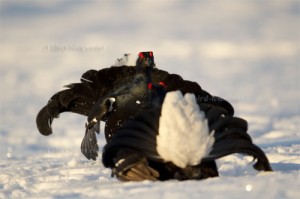 In Germany it is almost a dying experience: the sound of Black Grouse (Tetrao tetrix) in early spring. The indigenous population in the Rhoen – a mountaninour area in the middle of Germany – is almost extinct. Only in the Alps a vital population still survives.
In Germany it is almost a dying experience: the sound of Black Grouse (Tetrao tetrix) in early spring. The indigenous population in the Rhoen – a mountaninour area in the middle of Germany – is almost extinct. Only in the Alps a vital population still survives.
If you want to take pictures of the Black Grouse in courtship, one should trip to Scandinavia – also from nature conservation point of view. It is not acceptable to expose even the last remnants of native populations to the stress of photography. In the spring of 2013 I was travelling in the vicinity of the Gulf of Bothnia to Oulu in Finland. During a workshop near this northern part of the Baltic sea in Finland from 5th – 8th of April 2013 I shot images of a hunting Great Grey Owl but also of Black Grouse. Early in the morning you have to be already in the wodden hides, which are lined up in front of a snowy area shining white in the cloudless dark sky. Gradually, the male Grouse come closer to their mating grounds. You can already hear their faint cooing.
More and more they move closer to their display site. In early March at the latest the first grouse cocks are in place on the lek sites. In the snow you can still see feather streaks from their wide-spread wings and traces of jumps of the previous days. Every male bird has its defined territory and a timely arrival might prevent battles. Nevertheless, after a short while many different fights are to be observed. Some cocks fight with almost everybody, others only defend their territory. This is often associated with a corresponding loss of feathers.
The black grouse lek lasts from mid-April to mid-May. During that time the display activity of the cocks is hightest. They fly to the lek site already an hour before sunrise, in May even two hours. The morning display lasts about five to six hours and proceeds in two stages: in the twilight and after sunrise.
Last year’s young and those older male birds that could not manage to defend their territory keep to the edges of the lek sites, display only for short periods, move around and often feed. They may visit several lek sites during this period.
If there are not displaying, the grouses can be seen in birch tops. They look like black-feathered bundles. In spring birch buds are a major part of the diet of the grouse..
The cooing of male Black Grouse can be heard in October mornings, too. The autumn bubbling of grouse cocks can be heard at the same lek sites as in spring. Only rarely a grouse hen appears in the lek site. Ornithologists explain the autumn display by the fact, that the daylight period is again as long as at the beginning of the spring leks in March. This might affect the hormons of the males, inducing lek behavior. This is something, which also happens with other Gallinaceous bird species like Hazel Grouse (Bonasa bonasia).
It is in October again when you can observe these impressive birds on undisturbed forest roads in Scandinavia. They are pecking at gravel from the ground. In their stomach the little stones grind the ingested food. Until now they have been feeding on forest berries. But it will not take long before they have to change to the winter diet.
To cope with the growing demand for top shots of the rarer species of the Palearctic Bird-Lens is keen to enrich the range of pictures of birds you can find in the western palearctic. Trips to remote places like in Finland to capture images of rare birds of western palearctic were very successful. The operator´s name of the workshop is Finnature. It is highly recommended. Most of other workshops run by Finnature – a tour operator based in Oulu – take place in January/February for a period of 2 – 4 days.
This nice image is only a first impression, what you will find in the gallery in the “Pictures Shop” very soon. Just give me a message, if I could serve you with an image needed before the new pictures are online.